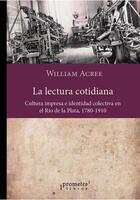In Latin America, Argentina and Uruguay are the most complete examples of the intersection between print media and collective identities. Nowadays a walk through the center of Buenos Aires or Montevideo reveals the strong presence of a written culture. This is reflected in the fact that since the late 1800s Argentina and Uruguay have the highest literacy rates in the region. How did written culture, literacy, and the public concern for reading and writing come to be so widely disseminated and integral practices of collective identity in both nations? How does everyday reading work? What is it that makes the link between print and the public sphere and politics in El Plata unique? Everyday reading answers these questions through a panoramic perspective of the growth of the printed culture of the River Plate from the arrival of the first printing presses on the threshold of the wars of ...read more
All book titles by this author
|
Title |
Price | ||
|---|---|---|---|
|
|
La lectura cotidiana Author: William Acree Publisher: Prometeo |
$520.00
15%$442.00 |
Shopping cart
Loading cart
Important notices
|
|
Recordando a André Rouillé: Su legado en la fotografía André Rouillé 1948 - 2025 |
|
|
Libros de filosofía y co. Disponibles en Librería Herder |
|
|
Revista Filosofía & Co. nº 9 Nueva revista de filosofia divulgativa y actualidad |
|
|
"Espacios de la filosofía" - Mauricio Beuchot - Novedad Herder México |
|
|
Revista Filosofía & Co. nº 8 Nueva revista de filosofia divulgativa y actualidad |
Pay safely with:


In the webshop
New
|
|
Humanos en el Antropoceno 69891 $525.00 -10.00% $472.50 |
|
|
Drag Kings 69889 $761.00 -10.00% $684.90 |
|
|
Autobiografía de un pulpo y otros relatos de anticipación 69473 $370.00 -20.00% $296.00 |
|
|
Enrique Dussel: Filosofar desde América Latina 69870 $660.00 -30.00% $462.00 |
|
|
Hipótesis comunista, La 69798 $360.00 -15.00% $306.00 |
In the press
Promotions
|
|
Catolicismo: Historia y Doctrina 20117 $1,200.00 -50.00% $600.00 |
|
|
Basiswörterbuch 28205 $390.00 -50.00% $195.00 |
|
|
Manual de la Biblia 20641 $2,410.00 -50.00% $1,205.00 |
|
|
Panorama B1.2 Curso 46507 $235.00 -35.00% $152.75 |
|
|
Panorama A1 Ejercicios. Ubungsbuch 39886 $395.00 -37.00% $248.85 |










